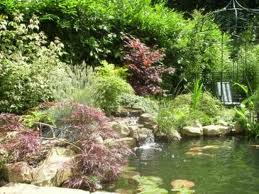





A gardener contemplating a water feature for the first time may believe that a natural water garden is the ultimate goal: an open body of water that has been created by nature and which is, therefore, in total harmony and sympathy with its surroundings. Although visually this may appear to be the case, in practical terms, a natural water garden can be the most difficult type of water feature to both organize and maintain.
 There are two kinds of natural water garden: the true naturally occurring body of water, and that which is created to have the appearance of a natural water feature. The genuine article is usually satisfactory visually, for its location will have been decreed by natural forces. While its general outline may merit some development, in all other respects, it is likely to be at a suitable point in the landscape.
There are two kinds of natural water garden: the true naturally occurring body of water, and that which is created to have the appearance of a natural water feature. The genuine article is usually satisfactory visually, for its location will have been decreed by natural forces. While its general outline may merit some development, in all other respects, it is likely to be at a suitable point in the landscape.
Although the position of a naturally occurring pond may be satisfactory for an open-water feature, it may not be perfect for plants. Shade from nearby trees, for example, may preclude a balanced planting. Such a pool may not necessarily be a clean and healthy body of water when left to its own devices, so some adjustments to the immediate environment may be required.
However, provided there is a constant water source and the water levels do not fluctuate substantially, this type of feature can be one of the most rewarding to manage. There are so many opportunities for artistry in planting when working with a natural pond. As long as the behaviour of various plant groups is understood, an easily maintained picture can be created. Only when planting with ill-mannered species are problems likely to arise.
Often, a naturally occurring pond will need some subtle landscaping to ensure that it is practical to manage. This usually involves providing a more gentle marginal slope so that the edges can be planted satisfactorily. Sensitive grading of the surrounding soil can greatly enhance the appearance of a natural body of water, without affecting its ecology or stability.
An artificially contrived, natural looking water feature is probably the most difficult for the water gardener to create. Most domestic gardens are unnatural in their position and design, and here we are trying to introduce a natural countryside feature. Considerable skill is needed to get it right, but, with care and an understanding of how water appears in a natural landscape, it is possible to achieve such a feature.
Primarily, water only appears at a low point, so when deciding how it will fit into the garden, it is vital to consider the existing land-form and determine how water can be introduced, either by using existing features, or creating the minimum of disturbance. Careful ancillary planting should always be considered before moving earth. Often, this can produce a deception that suggests the pond is in a natural setting and at an appropriate level in the landscape, when in fact that is not the case.
Natural bodies of water rarely produce constricted or sharp edges. Water erodes the soil in these situations, while the surrounding contours are always smooth and gentle. Steep sides only occur naturally where the ground around the pond is immovable, normally when it consists mostly of rock and the water has washed out the soft soil between.
Some natural water features are extensive and provide their own particular benefits and problems. The greatest benefit is the minimal change in water temperature and, therefore, the greater ease with which an ecological balance can be maintained. Rapid temperature changes encourage the regular development of algae, a potentially major problem in small bodies of water. In large areas of water, where algae appears to be troublesome, the problem is often caused by the run off of agricultural fertilizers from surrounding land, which introduces additional nutrients.
Wave action is probably the most important factor to be aware of with a large body of water. A surprising amount of erosion can be produced by the action of waves created by the wind. In some cases, netting must be fastened to banks and planted through to ensure a stable edge. This may even be necessary where the land slopes gently into the water.
As with a small pool, nature generally creates its own slopes, which are the result of natural erosion. With large bodies of water, the edges are often much shallower than those of ordinary ponds, and in many cases consist of stone beaches. These are formed because the soil is gradually washed away until only an accumulation of stones remains. When constructing a very large pool or lake, it is prudent to incorporate such unplanted beach features, especially at the main potential points of erosion. Planted edges are good for general stability and the prevention of sheet erosion, but they can be undermined by strong eddies and currents.
Copyright © www.100flowers.win Botanic Garden All Rights Reserved